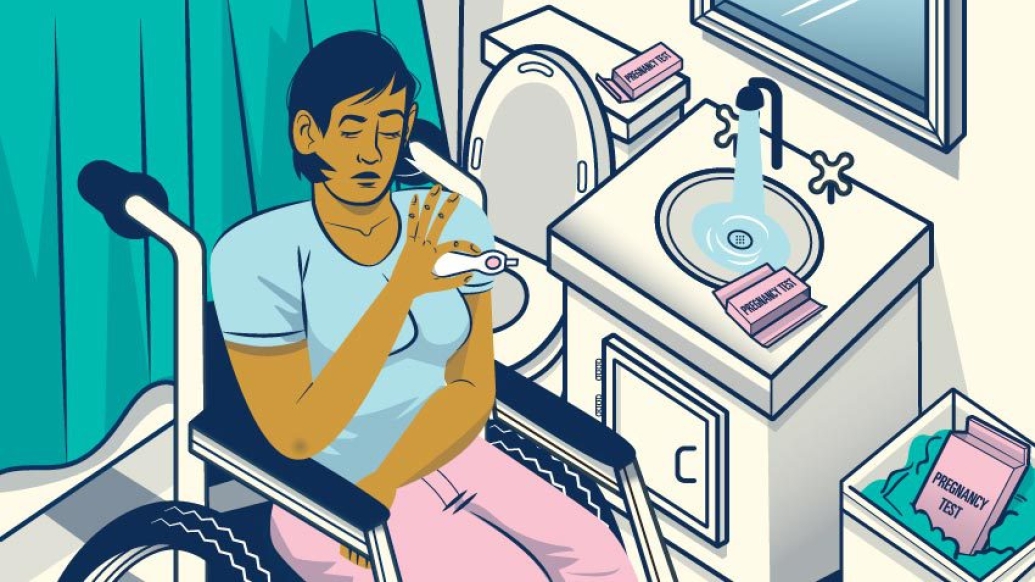What researchers learned is being used to create the first patient-reported outcome measures for reproductive health in this population.
3:13 PM
Author |

For many women with physical disabilities, the basics of reproductive health come with unique challenges.
That's not news to medical community, but providers do not have a way to measure the experiences of these women and how they relate to those without such conditions, said Claire Kalpakjian, Ph.D., M.S., associate professor of physical medicine and rehabilitation at Michigan Medicine.
"We've known for several decades that these are areas where many women face challenges, but what we haven't done is start to create solutions to these problems," Kalpakjian said. "You can't fix what you can't measure, so we need to create measures that show us the scope of the issues, how many people are affected and in what ways. This is what we need to inform ways we can intervene and change things."
During the study, Kalpakjian conducted focus groups and interviews with 85 women with disabilities across the country to understand what drives reproductive health inequity. Most of the women had moderate-to-severe disability, living with conditions like spinal cord injury, multiple sclerosis or cerebral palsy. Over the next two years, the research team sifted through the women's stories to find the most important issues related to their reproductive health and what needed to be measured first.
Periods
One of the key areas of focus was managing menstruation and premenstrual symptoms.
"You can't just get up and go lie down when you need to; you need help with that," one participant said. "I have scoliosis and my hips are tilted, so it takes a lot of work to line up a pad accurately. That's very hard to get right."
Managing cramps, leakage and using products like pads or tampons without good balance or dexterity can interrupt a woman's life monthly for years.
"I still remember one woman telling me because she sits all day and has no feeling down there, her pad would move around and constantly ruin her clothes," Kalpakjian said. "There's mental burden of managing it, in addition to just being able to physically manage it."
Since 1976, researchers found only four published studies that address menstrual hygiene among women with physical disabilities and a few on product preferences.
"This is just a shocking lack of attention to periods given half the population has them for decades of their life," Kalpakjian said.
Pelvic exams
In most medical offices, examination tables don't lower. Many of the interviewees shared a fear of falling off the table, if they were able to get up at all. While less common, some struggled with lower-body muscle spasticity with the insertion of the examination device called a speculum, triggering uncontrollable motion. Some worried about inadvertently kicking the person doing the exam.
Researchers were struck by the women who reported difficult interactions with their health care providers. They worried about being judged, rushed through the exam or not receiving accommodations to even have one.
"There's this dimension of human interaction that could really help or harm the experience," Kalpakjian said. "For some women, that's just too much work, so they don't bother with it. There can be some serious unintended consequences if you don't get the proper screening."
Like Podcasts? Add the Michigan Medicine News Break on iTunes, Google Podcasts or anywhere you listen to podcasts.
Sexuality and contraception
Beyond the physical dynamics of sexual activity – positioning, comfort and pleasure – many of the women felt a serious lack of understanding from health care providers about their sexual needs and desires.
"A lot of women talked about the assumption of their health care providers that sex was not even relevant to them," Kalpakjian said. "If they wanted contraception, providers would wonder why they wanted to know, like it never occurred to them they were sexually active."
Because limited data exists about the safety of certain oral contraceptives and intrauterine devices, or IUDs, for women with disabilities, many of them reported having to "fight" with their providers to get those resources.
"The health care providers tend to avoid risk for their patients, so often the default is 'no, it's not safe,'" Kalpakjian said. "That's a lot to have to negotiate to get contraception when there isn't really strong evidence one way or the other in the literature to guide those decisions for both women and providers."
Pregnancy
"Can I have a baby?"
Some women with physical disabilities spend years, going from provider to provider, trying to answer this question.
"I was told, 'Why would you want to bring a child into this world?'" one participant said. "I had to go in-depth with my disability and find out if it's possible for me to give birth to a 'normal child.'"
For the first time ever, we will have measures for women with physical disabilities about what matters most to them for their reproductive health. That is how you start designing actual solutions to create meaningful change.Claire Kalpakjian, Ph.D., M.S.
This is another moment for this population where the power often shifts drastically from patient to provider, Kalpakjian said.
"Health care providers struggle themselves with limited information to guide them, and women are frustrated by a lack of information, too," she said. "There can be a lot of negotiation around this issue that women without disabilities don't have to deal with. It's very frustrating for everyone."
SEE ALSO: New Tools to Help Women with Physical Disabilities Make Decisions about Pregnancy
Evidence is also mounting that women with physical disabilities who do give birth are more likely to have a cesarean birth than women without such conditions. Some of those may not be warranted though, Kalpakjian said.
"At the last minute, the health care provider may get spooked and throw the whole birth plan out the window," she said. "The cesarean birth can be warranted for many women with physical disabilities, but there is sometimes more of a knee-jerk reaction than a thoughtful conversation."
Seeking solutions
The physical barriers built into the environment make it more difficult for women with physical disabilities to fully realize their reproductive health journeys. But all five of the central problems discussed highlight a deeper issue: ingrained biases and generally limited knowledge of patient disabilities in the provider communities are compromising quality and access to care.
Creating an environment in which women with physical disabilities feel comfortable and cared for first and foremost requires listening to the patients, the team concluded. More structurally, it will take an overhaul of the way in which providers are trained to care for this historically underserved population, Kalpakjian said.
What the team learned is now being used to create the first patient-reported outcome measures for reproductive health in women with disabilities. PROMs, as they're sometimes called for short, have become common in health care research and quality improvement for many kinds of care, and form the basis for surveys, questionnaires and other tools that can guide efforts to improve care and health policy.
"These kinds of measures are designed based on what the patient says is important to them, not what others think should be important," Kalpakjian said. "They are meant to bring the patient's voice into the conversation. For the first time ever, we will have them for women with physical disabilities about what matters most to them for their reproductive health. That is how you start designing actual solutions to create meaningful change."
SEE ALSO: Expanded Birth Control Coverage May Help Reduce Disparities in Unplanned Pregnancies
Paper cited: "A Conceptual Framework for the Development of New Patient-Reported Outcome Measures," Journal of Women's Health. DOI: 10.1089/jwh.2019.8174

Explore a variety of healthcare news & stories by visiting the Health Lab home page for more articles.

Department of Communication at Michigan Medicine
Want top health & research news weekly? Sign up for Health Lab’s newsletters today!





